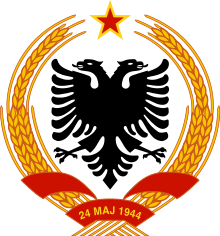Albanian People's Army
| Albanian People's Army | |
|---|---|
 | |
| Active | 1951–1991 |
| Country | People's Socialist Republic of Albania |
| Type | Army, Navy, Air Force |
| Size | 48,000 |
| Garrison/HQ | Tirana |
| Colors | Red And Black |
The Albanian People's Army (Albanian: Ushtria Popullore Shqiptare, UPS ) was the army of the People's Socialist Republic of Albania from 1946 to 1990. It took part in the Warsaw Pact until it withdrew in 1968. It was dissolved in 1990 and retained its current form through the Albanian Armed Forces.
History
After 1946 Albania became a part of the Eastern Bloc and under Soviet influence.Like all other Communist states, the UPS was subjected to the rule of the Party of Labour of Albania. Most communist party elites had high ranks in the UPS.The Ideology of Marxism–Leninism was enforced strictly by Political commissars to increase government control over the UPS.On May 1, 1966 the military ranks were changed to the ranks of the Chinese Army during the Sino-Soviet split.One of the things that changed during the period was the role of the military commander was smaller due to the role of the political commissars. Before 1948 the UPS was heavily funded by Yugoslavia after however, after relations declined between the two countries Albania turned to the Soviet Union of military aid. In 1960, as the Sino-Soviet split was starting the UPS switched its military alliance from the Soviet Armed Forces to the PLA.
The Militia of Albania is People's Volunteer Guard
Leadership
- Enver Hoxha (22 October 1944 – 1 August 1953)
- Beqir Balluku (1 August 1953 – 29 October 1974)
- Mehmet Shehu (29 October 1974 – 26 April 1980)
- Kadri Hazbiu (26 April 1980 – 14 October 1982)
- Prokop Murra (14 October 1982 – 9 July 1990)
- Kiço Mustaqi (9 July 1990 – 12 May 1991)
- Ndriçim Karakaçi (12 May 1991 – 11 June 1991)
- Ndriçim Karakaçi (11 June 1991 – 18 December 1991)
- Spiro Moisiu (24 May 1944-August 1946)
- Mehmet Shehu (August 1946 - January 28, 1948)
- Beqir Balluku (January 28, 1948 - 1952)
- Petrit Dume (1952 - 1954)
- Arif Mema Hasko (1954 - 1956)
- Petrit Dume (1956 - July 1974)
- Sami Meçollari (July 1974 - December 1974)
- Veli Llakaj (1974 - October 13, 1982)
- Kiço Mustaqi (October 13, 1982- February 1991)
- Enver Hoxha (8 November 1941 – 11 April 1985)
- Ramiz Alia (13 April 1985 – 4 May 1991)
Components
The combined strength of the UPS by 1990 was 48,000 troops, half of which were conscripts, with over 375,000 suited for service.The largest branch was the ground forces, which took up three-quarters of the UPS.Most of its equipment were old Italian, Soviet, and Chinese weaponry.The infantry brigades lacked mechanization, operating only about 130 armored vehicles. army units would be vulnerable to attack by modern fighter-bombers.[1] The UPS Navy was the second branch and exclusively was the coastal defense forces of the country.The Naval forces numbered about 2,000 men, with almost one-half being conscripts.Patrol craft included 6 Chinese-made Shanghai-II fast inshore gunboats and two older Soviet Kronshtadt-class patrol boats.[2] The air force of the UPS was founded in April 1952 and consist of 11,000 personnel.The missions of the air force were to repel the enemy at the country's borders and to defend the national airspace.In 1970 the UPS switched from Soviet to Chinese made planes. Helicopters consisted of one squadron of C-5 transports, a Chinese-manufactured Soviet An-2; one squadron of Chinese Li-2 transports; and two squadrons of Chinese Z-5 helicopters.Attack aircraft included 2 squadrons of J-4's and 1 squadron of J-2 bombers, the most advanced plane in the UPS.[3]
Ranks
After the World War II when the Enver Hoxha regime took power, military ranks were radically changed in looks and in naming. The original design for ranks for the UPS came from the Soviet Union and the Eastern Bloc. In May 1966 military ranks were abolished following the Sino Soviet Split switching over to the Chinese example.
Equipment
The equipment of the UPS had lacked in modernization.These types included Soviet BTR-40, BTR50, BTR-152, BRDM-1 vehicles and Chinese Type-531 armored vehicles. Armored forces were equipped with 1100 T-34, T-54/T-55 and type 59 tanks made in the Soviet Union and China. Soviet and Chinese artillery in the ground forces inventory was towed rather than self-propelled. It included Soviet M-1937 and D-1 howitzers and 150 Chinese Type-66 152mm guns, Chinese Type-59 130mm guns, Soviet M-1931/37 and M-1938 guns of 122mm, and Chinese Type-60 guns of 122mm. Its naval fleet also included 4 whiskey class submarines, minesweepers, torpedo boats etc.
References
- ↑ "Albania Ground Forces - Flags, Maps, Economy, History, Climate, Natural Resources, Current Issues, International Agreements, Population, Social Statistics, Political System". www.photius.com. Retrieved 2016-09-14.
- ↑ "Albania Naval Forces - Flags, Maps, Economy, History, Climate, Natural Resources, Current Issues, International Agreements, Population, Social Statistics, Political System". www.photius.com. Retrieved 2016-09-14.
- ↑ "Albania Air and Air Defense Forces - Flags, Maps, Economy, History, Climate, Natural Resources, Current Issues, International Agreements, Population, Social Statistics, Political System". www.photius.com. Retrieved 2016-09-15.